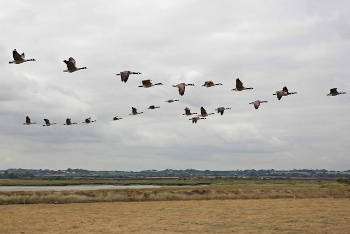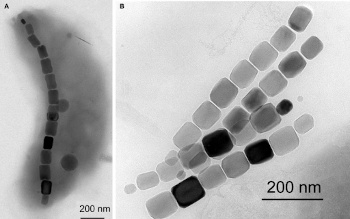Plant Crystals
December 5, 2022
Cold weather has arrived at
Tikalon's home in
Northern New Jersey, and that's a
signal for our
snowbirds to head
south for the
winter. For those not familiar with the term, a
snowbird is not a
migratory bird, but someone who
flees the cold
North for the sunny
South in the winter. However, unlike
birds who
neither sow, nor do they reap, you need to be
retired with a sizable
nest egg to be a snowbird.
Many bird
species migrate south for the winter, as the incessant and loud
honking of
Canada Geese and the sight of their
V-shaped flight formation clearly demonstrate in our area. Despite a migration of more than a thousand
miles, these birds are known to return to the same
nesting ground every year. That brings us to the question of how these birds
navigate. One way to head south is to keep the
rising Sun at your
left, and the
setting Sun at your
right. There's also the
possibility of a
learned route of
landmarks, such as
lakes and
rivers, passed on through
generations (A Canada goose has a
lifespan of about 10-20
years).

Canada Geese in V-formation.
This photo was taken at Northey Island on Blackwater Estuary, Essex, England.
(Wikimedia Commons image by Glyn Baker of Northey Flypast, licensed under the Creative Commons Attribution-ShareAlike 2.0 Generic License. Click for larger image.)
Canada geese also fly at
night, when the
Sun isn't visible and landmarks are seen only by
moonlight. It's thought that geese have a
physical compass in their
head that allows navigation by
detecting the
Earth's magnetic field. Birds have
materials containing
iron in their upper
beak that might enable this
magnetoreception. As might be expected, numerous
experiments have been done on
homing pigeons, which also have iron
clusters in their upper beak. It's thought that the
trigeminal nerve allows sensing of the magnetic
forces on these iron particles.
Iron is the fourth most
abundant element in Earth's crust and the first abundant element after the
aluminosilicate elements,
oxygen,
silicon, and
aluminum. As a consequence, iron has been incorporated into many
organisms, and some
bacteria have been found to contain
crystals of
magnetite (Fe3O4), a magnetic
iron oxide. As a consequence, these bacteria are
magnetotactic; i.e., their
motion is affected by a magnetic field.
Magnetotaxis in bacteria was discovered in 1963 by Salvatore Bellini. This discovery was
published only in
Italian and it was overlooked for many years. The
aphorism, "
publish or perish" should have instead been stated as, "publish
in English or perish." Magnetotaxis in bacteria was subsequently rediscovered in 1975 by Richard Blakemore.[2] The bacteria do not
sense the magnetic field as in magnetoreception; rather, their internal
magnets force the bacteria into
alignment with the field, and the response is seen also in
dead bacteria. Bacterial movement was observed by Blakemore in magnetic fields as weak as 0.5
gauss, about the
strength of Earth's magnetic field.[2] It's conjectured that the
evolutionary advantage in having such magnets aids these bacteria in reaching areas of optimal
oxygen concentration.

Magnetosomes of magnetite in magnetotactic Alphaproteobacteria.
Left is a transmission electron microscope image of a vibrioid magnetotactic bacteria from Lake Mead, Nevada, showing its contained chain of elongated magnetosomes.
Right is an image of two double chains of elongated magnetosomes from a freshwater coccus.
(Portion of a Wikimedia Commons image by Mihály Pósfai, Christopher T. Lefèvre, Denis Trubitsyn, Dennis A. Bazylinski, and Richard B. Frankel.)
Plants don't move very much and they would have little need of magnetic navigation crystals. However, they often contain another type of crystal,
raphides,
needle-shaped crystals of
calcium oxalate monohydrate or
calcium carbonate found in specialized
cells called
idioblasts that can also contain other substances, such as
oil. These crystals are found in more than 200
families of plants, and they appear to act as a
calcium reservoir, a defense against
grazing insects and
animals, and a means of
mechanical support. In some cases, calcium oxalate amounts to more than 5% of the plant's
dry weight.
Raphides were first described by
pioneer microbiologist,
Antonie van Leeuwenhoek (1632-1723), in the late
17th century.[3] Seventy-five percent of
flowering plants contain crystals.[3] Aside from raphides, plants can contain small
silica crystals.[3]
Some common plant items containing raphide are as follow:
• Beta (Beets, Swiss Chard)
• Spinacia (Spinach)
• Rheum rhabarbarum (Rhubarb)
• Ananas comosus (Pineapple)
• Actinidia (Kiwifruit)
.jpg)
Left, the raphide-containing Epipremnum aureum, appropriately named the devil's ivy. Right, a 600 magnification image of raphides from such a plant. (Left image, a Wikimedia Commons image by Joydeep. Right, a Wikimedia Commons image by Agong1. Click for larger image.)
An
international research team with members from the
Rheinische Friedrich-Wilhelms Universität Bonn (Bonn, Germany), the
Nees-Institut für Biodiversität der Pflanzen der Universität Bonn (Bonn, Germany), the
University of Wisconsin-Milwaukee (Milwaukee, Wisconsin), the
Hessisches Landesmuseum Darmstadt (Darmstadt, Germany), and the
Senckenberg Naturhistorische Sammlungen Dresden (Dresden, Germany), has found that
impressions of calcium oxalate crystals are found in
fossil plant remains, and they can be used as a means of fossil identification.[4-5] Their research is published in an
open access article in
Scientific Reports.[4]
Such fossil impressions were previously considered to be
granular traces of
algae or
pollen with no convincing explanation.[4] The present study shows that these
enigmatic microstructures were caused by calcium oxalate.[5] Says
Mahdieh Malekhosseini,
principal author of the study at the
Institute of Geosciences at the University of Bonn,
"Until now, it was not known how these cavities were formed... For example, it was believed that they came from algae or pollen from other plants that somehow got onto the leaf during fossilization. But after analyzing hundreds of these structures, we can rule that out. Instead, we were able to show that calcium oxalate crystals are responsible for the depressions."[5]
Oxalate crystals are not present in the fossil remains. What are found are cavities in which the oxalate crystals had been. That's because they are
soluble in even the weakest
acids, including
carbon dioxide (CO2)-
saturated water.[4-5] Sometimes other
minerals containing
calcium,
silicon,
aluminum,
sulfur, and
iron and
organic material accumulate in the depressions left by the
dissolved oxalate, where they sit like tiny
beads in the fossil leaf.[4-5] Fossils of
pines and
firs sometimes show these calcium oxalate crystal imprints, but these had not been discovered for
angiosperms, the flowering plants and
trees.[5] The present study discovered these in fossil angiosperm leaves from the
late Oligocene Rott Fossil Lagerstätte, and they were classified by
shape, size, and
distribution pattern, and compared with crystals in the leaves of
extant plants.[4]
_fossil.jpg)
fossil oak leaf of a Quercus neriifolia (left), compared with a leaf from a present-day oak (Quercus variabilis, right). The brown round deposits of the fossil resemble calcium oxalate crystals of present-day oak leaves (University of Bonn image, also available here. Click for larger image.)
The research team used
energy dispersive analysis by X-ray (EDAX) in a
scanning electron microscope for
element analysis.[4] Some of the questions that they addressed in their study were whether the shape and location of the oxalate crystals of the fossil leaves correspond to those of modern leaves, and what
chemical and
biochemical processes occurred during fossilization to change their
micromorphology.[4] Observation of granular structures caused by crystals can serve as an aid in fossil leaf assignment.[4] As Malekhosseini explains,
"We studied the microstructure of the pits and their distribution on fossil leaves whose species affiliation we knew... In addition, we looked at calcium oxalate crystals in the leaves of present-day plants. We found clear parallels in closely related species. For example, the crystal imprints in a fossil ginkgo leaf strongly resemble the calcium oxalate deposits of a present-day ginkgo in distribution and structure."[5]
References:
- Tom Langen, "How do geese know how to fly south for the winter?," The Conversation, November 16, 2020.
- Richard Blakemore, "Magnetotactic Bacteria," Science, vol. 190, no. 4212 (October 24, 1975), pp. 377-379, DOI: 10.1126/science.170679.
- Ivan Amato, "The Secret Life Of Plant Crystals," Chemical & Engineering News, vol. 84, no. 6 (February 6, 2006).
- Mahdieh Malekhosseini, Hans-Jürgen Ensikat, Victoria E. McCoy, Torsten Wappler, Maximilian Weigend, Lutz Kunzmann, and Jes Rust, "Traces of calcium oxalate biomineralization in fossil leaves from late Oligocene maar deposits from Germany," Scientific Reports vol. 12, Article no. 15959, September 24, 2022, https://doi.org/10.1038/s41598-022-20144-4. This is an open access paper with a PDF file here.
- New field of research: Crystal traces in fossil leaves, University of Bonn Press Release, October 7, 2022.
Linked Keywords: Cold; weather; Tikalon; home; Northern New Jersey; signal; snowbird (person); south; winter; bird migration; migratory bird; flee; Northern United States; Southern United States; bird; Matthew 6:26; neither sow, nor do they reap; retirement; retired; nest egg; species; animal migration; animal sound; honking; Canada goose; Canada Geese; V-shaped flight formation; mile; habitat; nesting ground; navigation; navigate; sunrise; rising Sun; relative direction; left; sunset; setting Sun; right; probability; possibility; learning; learned; route; landmark; lake; river; generation; longevity; lifespan; year; Northey Island; Blackwater Estuary; Essex; England; Wikimedia Commons; Glyn Baker of Northey Flypast; Creative Commons Attribution-ShareAlike 2.0 Generic License; night; Sun; moonlight; physics; physical; compass; head<; detection; detecting; Earth's magnetic field; material; iron; beak; magnetoreception; experiment; homing pigeon; cluster; trigeminal nerve; force; abundance of elements in Earth's crust; abundant element in Earth's crust; aluminosilicate; oxygen; silicon; aluminum; organism; bacteria; crystal; magnetite (Fe3O4); iron oxide; magnetotactic bacteria; motion (physics); magnetotaxis; scientific literature; publish; Italian language; aphorism; publish or perish; English language; sense; magnet; parallel (geometry); alignment; death; dead; gauss (unit); magnetic field strength; fitness (biology); evolutionary advantage; oxygen; concentration; magnetosome; Alphaproteobacteria; transmission electron microscopy; transmission electron microscope image; vibrio; vibrioid; Lake Mead, Nevada; chain; freshwater; coccus; plant; raphide; acicular crystal habit; needle-shaped; calcium oxalate monohydrate; calcium carbonate; cell (biology); idioblast; vegetable oil; family (biology); calcium; reservoir; grazing; insect; animal; stiffness; mechanical support; dry matter; dry weight; innovator; pioneer; microbiologist; Antonie van Leeuwenhoek (1632-1723); 17th century; flowering plant; silicon dioxide; silica; Beta (Beets, Swiss Chard); Spinacia (Spinach); Rheum rhabarbarum (Rhubarb); Ananas comosus (Pineapple); Actinidia (Kiwifruit); Epipremnum aureum; devil's ivy; magnification; image; Joydeep; Agong1; international; research; Rheinische Friedrich-Wilhelms Universität Bonn (Bonn, Germany); Nees-Institut für Biodiversität der Pflanzen der Universität Bonn (Bonn, Germany); University of Wisconsin-Milwaukee (Milwaukee, Wisconsin); Hessisches Landesmuseum Darmstadt (Darmstadt, Germany); Senckenberg Naturhistorische Sammlungen Dresden (Dresden, Germany); impression; fossil; open-access journal; open access article; Scientific Reports; granular material; granular traces; algae; pollen; enigma; enigmatic; microstructure; Mahdieh Malekhosseini; academic authorship; principal author; Institute of Geosciences at the University of Bonn; cavity; solubility; soluble; acid; carbon dioxide (CO2); saturation (chemistry); saturated; water; mineral; calcium; silicon; aluminum<; sulfur; iron; organic compound; organic; dissolution (chemistry); dissolved; bead; pine; fir; angiosperm; tree; late Oligocene; Rott Formation; Rott Fossil; Lagerstätte; shape; extant; oak; Quercus variabilis; energy dispersive analysis by X-ray (EDAX); scanning electron microscope; chemical element; element; analysis; chemistry; chemical; biochemistry; biochemical; chemical process; morphology (biology); micromorphology; ginkgo; ginkgo biloba; present-day ginkgo.